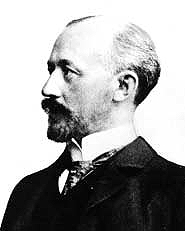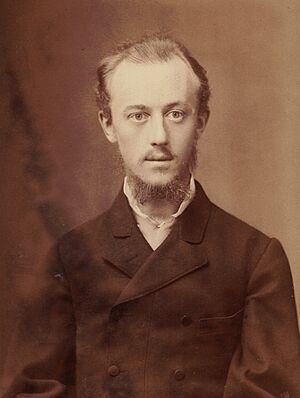Mikhail Dolivo-Dobrovolsky facts for kids
Quick facts for kids
Mikhail Dolivo-Dobrovolsky
|
|
|---|---|

Dolivo-Dobrovolsky around 1908
|
|
| Born |
Mikhail Dolivo-Dobrovolsky
2 January 1862 |
| Died | 15 November 1919 (aged 57) |
Mikhail Osipovich Dolivo-Dobrovolsky (Russian: Михаи́л О́сипович Доли́во-Доброво́льский) was a brilliant Russian Empire-born engineer and inventor. He was active in Germany and Switzerland. He is famous for his work with polyphase electrical systems.
Mikhail helped create the three-phase electrical generator and electrical motor in 1888. He also studied how to connect these systems. His three-phase system was a huge success at the International Electro-Technical Exhibition in 1891. There, he showed how to send electricity 176 kilometers (about 109 miles) with 75% efficiency. In 1891, he also invented a three-phase transformer and a special induction motor. He even designed the world's first three-phase hydroelectric power plant that same year.
Contents
Mikhail's Life Story
Mikhail Dolivo-Dobrovolsky was born in 1862 in Gatchina, near Saint Petersburg, Russia. His father was a government worker of Polish background. His mother came from an old Russian noble family.
Mikhail spent his school years in Odesa. At 16, he went to the Riga Polytechnic. This college taught in German language. In 1881, many students, including Mikhail, were forced to leave because of political problems in Russia.
After leaving Russia, Mikhail moved to Germany in 1883.
He studied electrical engineering at the Technische Universität Darmstadt from 1883 to 1884. This was one of the first places in the world to teach electrical engineering. He worked as an assistant there and published several papers.
After his big inventions, Mikhail kept researching electricity. He invented the phase meter in 1892 and the ferrodynamic wattmeter in 1909. He gave many talks and wrote papers. From 1903 to 1907, he worked in Lausanne, Switzerland. He became a Swiss citizen in 1906.
Later, he returned to Berlin and continued working at AEG. He became the Technical Director of their factory in 1909. In 1911, he received an honorary doctorate degree. A building at his old university is named after him today. During his life, he received over 60 patents for his inventions.
Mikhail Dolivo-Dobrovolsky passed away in 1919 from a heart condition. He was buried in Darmstadt, Germany. A street in Darmstadt was named Dolivostraße in his honor in 1969.
How He Invented the Three-Phase System
In 1887, Mikhail joined Allgemeine Elektricitäts-Gesellschaft AG (AEG) in Berlin. He worked there for the rest of his life. At first, he tried to improve direct current (DC) technology. This was because AEG started as a company linked to Thomas Edison, who used DC.
But then, alternating current (AC) started to get more attention. AC is different from DC. Engineers in Budapest had designed the first modern transformer in 1885. However, AC technology needed better equipment, especially motors that could start on their own.
Before Mikhail, an Italian inventor named Galileo Ferraris created the first AC motor in 1885. Also, a German engineer, Friedrich August Haselwander, made the first AC three-phase synchronous generator in Europe in 1887.
In 1888, Mikhail found a new solution at AEG. He worked with a special type of alternating current called "chained three-phase alternating current." He even created the term "three-phase current." His asynchronous motor was the first working motor of its kind.
Early asynchronous motors had a problem: they didn't have much power when starting. Mikhail solved this with the slip ring motor in 1891. This motor could start with high power.
By early 1889, the first AEG three-phase motors were running. They soon produced 2 to 3 horsepower. Mikhail made sure the parts were well-designed for good performance. In 1891, he also developed the first Delta-wye transformer for this system.
Sending Electricity Far Away
AEG and their Swiss partner, Maschinenfabrik Oerlikon (MFO), had all the parts for a three-phase system. But they had only tested it in small trials.
Then, a bold idea came up for the International Electrotechnical Exhibition in 1891 in Frankfurt. The plan was to show how three-phase current could send power from Lauffen am Neckar to Frankfurt. This was a distance of 175 kilometers (about 109 miles)!
Mikhail and his partner, Charles E. L. Brown, made this project happen. A large three-phase AC generator at MFO was powered by a water turbine. It created electricity at 50 volts and 40 Hertz. This power was then boosted to 15,000 volts (later 25,000 volts) using transformers.
The electricity traveled through overhead lines to Frankfurt. There, it was lowered back down to power a 100-horsepower asynchronous motor and about 1,000 incandescent lamps (light bulbs).
The system started working on August 24, 1891. A test team found that 75% of the energy generated in Lauffen reached Frankfurt. This proved that alternating current was great for supplying electricity to many people over long distances. It also showed that three-phase technology was now as good as direct current technology.
This demonstration at the exhibition made three-phase AC technology famous. It helped AEG become a global company. Later, Mikhail changed the standard frequency to 50 Hertz. This was because 40 Hertz could cause lights to flicker, which was annoying to the human eye.
Sources
- https://web.archive.org/web/20050908025431/http://erudite.nm.ru/DolivoDobr.htm
- https://web.archive.org/web/20110926231334/http://library.istu.edu/hoe/personalia/dolivo.pdf


